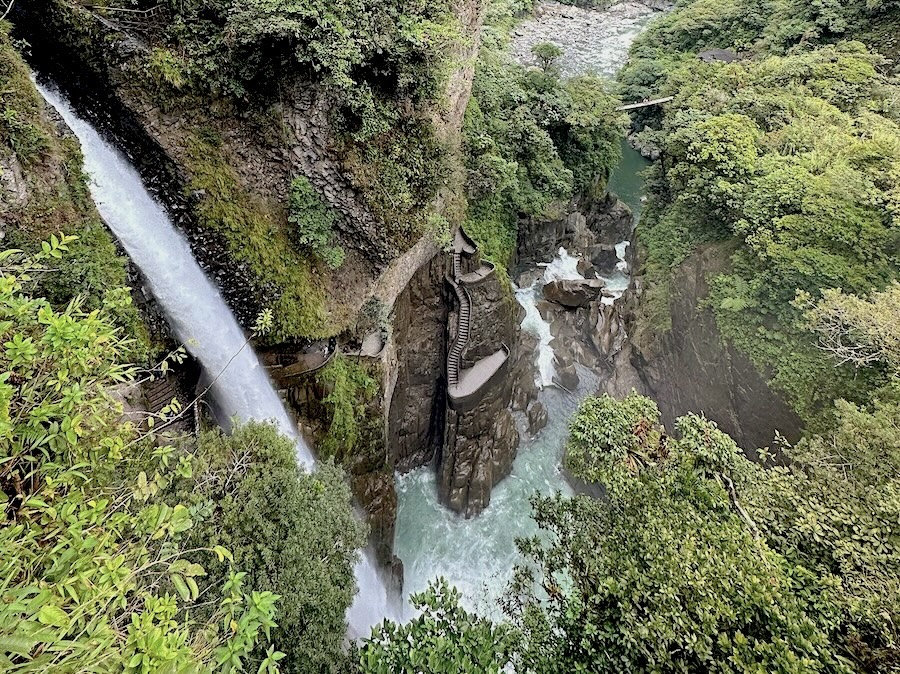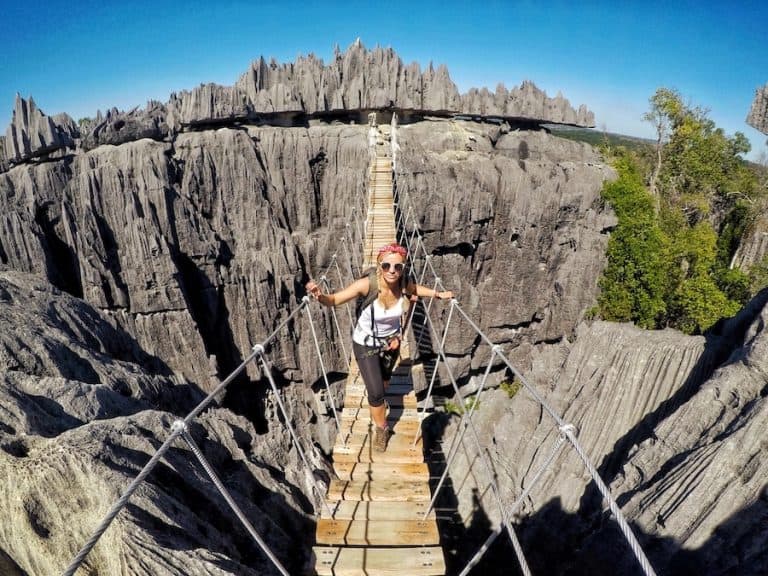Is Madagascar Worth Visiting In 2024? Complete Guide & Best Things To Do

Is Madagascar worth visiting in 2024? What are the best things to do in Madagascar?
Are you looking for a unique, diverse country filled with unique flora, fauna and once-in-a-lifetime experiences? Then you’re probably looking for Madagascar!
Just make sure you’re not looking to visit the fourth largest island in the world to look for lions, zebra, giraffes and hippos. Despite the name, this is definitely not a DreamWorks movie!
Instead, you’ll find that animals that live in the rainforests, mountains and deserts of this diverse land are unique to Madagascar.
We travelled through this spectacular country and now I want to tell you exactly why Madagascar is worth visiting!
Is Madagascar Worth Visiting?
Yes! Madagascar is definitely worth visiting, especially for nature lovers and those who looking for a bit of adventure! We spent a couple of weeks exploring the country and met others who felt the same way.
Free from human colonisation, until around 2000 years ago, ‘The Red Island’ remains largely unspoiled and is one of the last places in the world where you can really have an adventure of a lifetime!
In fact, 90% of the flora and fauna are endemic, meaning that they are found nowhere else on Earth! Madagascar only sees a few hundred thousand tourists annually, and some of the national parks only see a few hundred visitors each year!
You see why it’s not difficult to wander off the beaten track and those who believe that ‘getting there is half the fun’ will be greatly rewarded!
What Is Madagascar Famous For
Apart from a certain group of movie characters, not everyone will know what Madagascar is famous for!
Madagascar is nicknamed the Red Island due to the red soil which is high in aluminium and iron. If you’ve ever seen the movie Madagascar, you’ll know that animals such as lions, zebra etc don’t live on this large island.
The wildlife in Madagascar has taken a different evolutionary path from those in mainland Africa. Lemurs are the king of the jungle here (King Julien, anyone?) and you can find over a hundred different species of them depending on where you visit.
You’ll also find hundreds of different species of reptiles, birds and insects and thousands of species of plants. Much of the flora and fauna in Madagascar can be found nowhere else on Earth!
Madagacas’s coastline also offers great opportunities to go whale watching, relax at the beach or do some diving or snorkelling. It really has it all!
Brief History of Madagascar
What happens when a piece of Africa is separated off the east coast and allowed to evolve for 88 million years? Madagascar! That’s what happens!
After millennia of complete isolation (and evolution), migrants from Indonesia, and later Mozambique, settled in Madagascar around 2000 years ago. A quick look at the history books will see stories of pirates, traders and explorers until the rise of the Merina Kingdom in the early 19th century.
Seven kings and queens (including ‘The Mad Queen’ Ranavalona I) ruled during this time until the French invasion in the 1890s. The royal family were exiled to Algeria and the short-lived Merina Monarch ended.
Madagascar gained its independence from the French, after a period of revolt, in 1960 and it’s easy to find their influence wherever you go. From the language to the cuisine, it’s easy to see why the majority of visitors are from French-speaking countries.
Best Things To Do In Madagascar
So what is there to do in Madagascar? From ring-tailed lemurs to epic landscapes, and beach escapes, a trip to Madagascar is a truly unique experience.
1. Antananarivo – Madagascar’s Capital City

Most people who visit Mada will have to go through the ordeal of staying in ‘Tana’ at some point. Nearly everyone will tell you to leave as soon as possible.
Whilst we agree that it’s probably not the most charming or inviting city we’ve visited, there are still a few things worth seeing such as The Ambohimanga Rova (Queen’s Palace) and the Catholic Cathedral. Why not visit Lemur’s Park where you can play with semi-wild lemurs like ‘King Julien’?

We really enjoyed Ambohimanga – a UNESCO World Heritage Site located about 25km north of Tana. The drive takes about one hour due to the city’s infamous traffic (try not to breathe in all the fumes!) This is one of the most important, and best-preserved monuments of the Merina Kingdom.
We also liked the colourful Analakely market – the perfect way to immerse ourselves in local Tana life.
➡️ Check Out This Day Trip To Ambohimanga Rova Here!
2. Andisabe – Mantadia National Park

After a three-hour journey from Tana, you’ll arrive at Andasibe National Park – one of the most visited parks in Mada.
Comprising of the Analamazaotra Special Reserve, and Mantadia to the north, the protected rainforests are home to many lemur species but there is one in particular that everyone comes to see the indri. The Indri is the largest of the lemur species and their haunting calls can be heard throughout the forest, making them easy to find.
The guides here make it their duty to spot Indri for you. We spent most of our hike off the main path as our guide was determined to find the Indri before we left.
We also visited the Vakona Forest Lodge where we were taken to Lemur Island – a small island where rescued semi-wild lemurs reside. This was the perfect place to get up close and personal with Madagascar’s most famous residents.
➡️ Check Out This 3-Day Andisabe Tour Here!
3. Avenue of The Baobabs – Bucketlist Destination

One of the main reasons we visited Mada was to see the legendary baobab trees that litter the west coast. The most famous place to see them is The Avenue of The Baobabs and it was on our bucket list. These magnificent specimens can reach a height of over 30 metres and some trees are said to be hundreds, or even thousands, of years old.
Located 17km northeast of Morondava, a beach town on the West coast, a visit to ‘Baobab Avenue’ is a must and can be organised by your hotel (they always know a driver) or by taxi. The road to Baobab Avenue soon turns into a bumpy, dusty, dirt road so, as tempting as it seems, tuk-tuks are probably avoided on this journey!
A visit at sunset or sunrise, or both, is highly recommended. Don’t expect to have the place to yourselves though. Even arriving at 5 am for sunrise, there were already groups of people on the avenue taking photos. At least we had someone to take our photo for us!
➡️ Check Out This Day Trip From Morondava To Kirindy & The Avenue Of The Baobabs!
4. Tsingy de Bemaraha – The Stone Forest
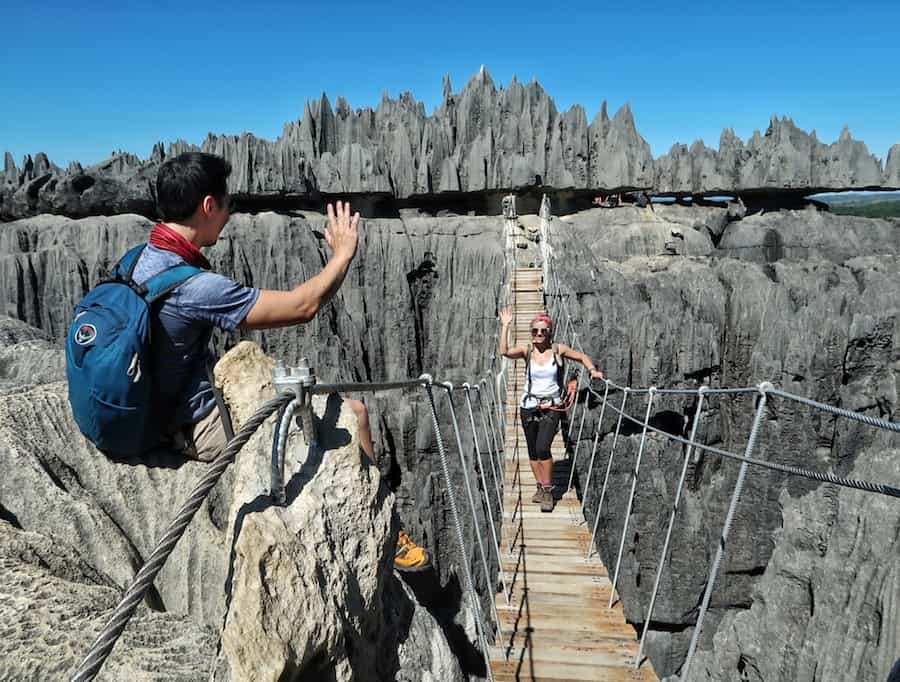
The stone forests of Tsingy National Park are a highlight for anyone visiting the west coast. A full day’s drive from Morondava in a 4×4 on a bumpy dirt road is needed to get there. With its jagged, limestone landscape and the possibility to spot lemurs, this is a place not to be missed.
It’s easy to see why they named the park Tsingy as this roughly translates to where one cannot walk barefoot in Malagasy. A limestone seabed 200 million years ago, heavy rainfalls have eroded the cliffs into the spectacular, jagged valley we see today.
The park is split into the Great Tsingy and Petite Tsingy, we hiked for hours around this magnificent park. We crossed rope bridges, squeezed through caves and spotted some wildlife in this other-worldly place.
➡️ Check Out The Best Tsingy 4-Day Tour Here!
5. Isalo National Park
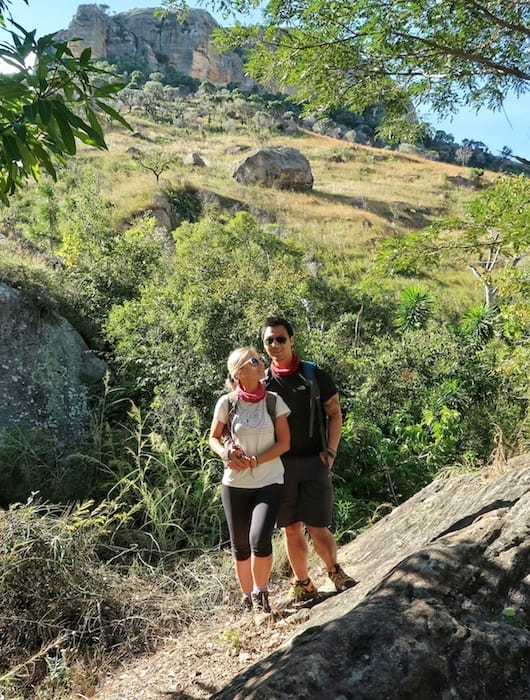
Madagascar has many tropical rainforests but for something slightly different, try Isalo National Park. Looking more like something from the American West, Isalo combines desert landscapes with deep lush canyons.
A hike through this reserve can bring you along the rocky terrain, through lemur-inhabited forests and even alongside waterfalls.
6. Ranomafana National Park
Meaning ‘hot water’ in Malagasy, this mountainous rainforest is one of the most picturesque reserves in Madagascar. Located about 7 hours from Antananarivo, the park was created in 1991 due to the discovery of the golden bamboo lemur.
With 12 species of lemur living here as well as 115 bird species and 62 different reptiles, Ranomafana is one the best places to see Madagascar wildlife.
💡Pro Tip: All national parks in Madagascar require a guide. Prices will depend on the park visited and the length of your hike.
7. Madagascar Beaches

Does Madagascar have nice beaches? Of course, it does! Being a huge island with 5000km of coastline, you’re sure to find stunning beaches as well as many beautiful islands.
Nosy Be is probably the most popular, and expensive, island located in the north. Whale sharks are the main attraction and visit from September to December.
For more peace and quiet, Ile Sainte Marie lies on the east coast and was a popular base for pirates in the 17th and 18th centuries.
During our off-road drive down the west coast, we passed beautiful places such as Morembe and Andavadoaka. These places are not written about much, due to the difficulty of getting there, and we only saw a handful of other tourists.
We highly recommend a few days in beautiful Salary Bay – a gorgeous 7km stretch of white beach without any other people to share it with. More on this later.
➡️ Check Out These Superb Bungalows On Nosy Be!
Best Time To Visit Madagascar
The best time to visit Madagascar would depend on what you really want to see. The start of peak season runs from the end of April/beginning of May through to December. We arrived in May and there still weren’t many tourists around!
There were sunny days in Antananarivo as well as rain and chilly evenings. This time of year is considered to be winter in the southern hemisphere too. It didn’t feel like it during the 38°C temperatures on the west coast!
Madagascar can be enjoyed all year round but, having said that, it’s a huge country and the climate will vary depending on your location. The wet season, from late December to March, is probably best avoided as a lot of roads are closed or become impassable and places like Tsingy de Bemaraha National Park will be closed.
Beach destinations like Nosy Be are still possible from September to November as the weather is hot and the heavy rains won’t come until December.

One thing to consider when planning your trip is the wildlife. Lemurs are the main draw here and can be seen all year round in the reserves, however, visiting in October or November would increase your chances of seeing baby lemurs!
Humpback whales visit these shores from July to September and from September to December, whale sharks visit the island of Nosy Be.
How To Get To Madagascar
This will be one of the most difficult parts of any visit to Madagascar. There are only direct flights to Madagascar from Paris with the UK, US and Australia requiring a transfer, normally at an African airport.
Flights from Heathrow cost around £750/$900 upwards, but the stopover times are longer unless you pay a bit more. Flights in July will cost around £1200/$1400 or more due to this being the peak season for Madagascar.
Our flight from London cost us just over £650/$800 per person as we visited in April, and we had a long stopover in Addis Ababa, Ethiopia. I would recommend paying that little bit extra to reduce the time spent in an African airport (no offence to the Egyptian and South African airports!)
Bole International Airport, in Addis Ababa, is stuffy with no air-con and without a lot of options to entertain ourselves. Once the security desks open, expect a lot of pushing, and shoving and people just generally do not give a damn that you’re in their way!
➡️ Check The Latest Prices On Flights To Madagascar ✈️
Madagascar Visas
As of 2024, there is no need for a visa if your stay is less than 15 days. Considering a two-week trip (including flights, layovers etc.) should be sufficient for most, this is great news! There is now a mandatory 10 Euro admin fee on arrival though.
Most travellers will need to adhere to the standard 6 months remaining in their passport and proof of onward travel rule, as well as two blank pages.
Visa fees, as of 2024
You can get a visa-on-arrival if your stay is longer than 15 days. The visas must be paid in cash using US dollars, Euros, or Malagasy Ariary. The fees are:
30 Days – 35 Euros / 37 USD / 115,000 MGA
60 Days – 40 Euros / 45 USD / 135,000 MGA
You can also apply for a visa in advance through your local embassy or consulate. There is an option to extend the visa to 90 days through the immigration service should you wish to do so.
Arrival At Madagascar
Ivato International Airport, in Antananarivo, will be one the of things you will want to forget in a hurry! You will be handed your visa forms to fill in at the airport on arrival, not on the plane.
Once the paperwork is complete, you then join a very slow-moving queue… three times! The first queue is to check the visa form. Then another queue to pay for the visa. Then, the longest wait is for them to actually give you the visa.
In a tiny airport, with no air-con, the wait is frustrating enough. What will annoy you more is the number of people who get their visas before you when you were sure you were in front of them.
Bribery is rife in Madagascar and even airport security guards have no problem accepting them! This is where we first thought to ourselves ‘is Madagascar worth visiting’ with all this hassle and corruption!
After finally getting your visa, you may be asked to present your passport several more times (five in my case!) Once in the arrivals hall, you have a chance to use the ATM or the currency exchange to get your Ariary.
The exchange rate isn’t amazing but certainly better than some hotels. Euros and US Dollars give a slightly more favourable rate than British Pounds. Now is also a good time to get a local SIM (we were told Telma provided the best service.)
Tip | When leaving Madagascar, try to use all your Ariary BEFORE check-in/security. For some strange reason, many of the shops in the departure lounge only accept Euros or US Dollars!
How To Get Around Madagascar
Patience is the key! And there will be times when yours will be pushed to the limit. Tourism is slowly growing in Madagascar, but the infrastructure still remains a problem.
Many of the national roads between locations are either unpaved or in terrible condition meaning long travel times and uncomfortable journeys. You will also be sharing the roads with goats and zebu as well as children and people as there are no footpaths.
This, of course, is all part of the adventure!
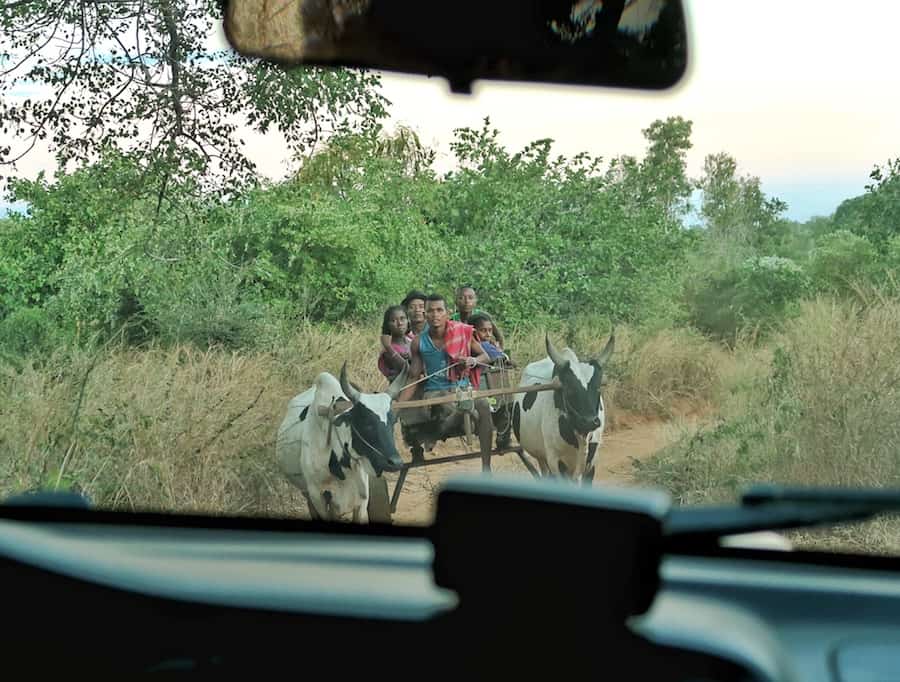
Transfer From The Airport
The airport is around 16km from the city and the journey usually takes around one hour (I know!!) On exiting the airport, or more likely before, you will probably be approached by one of the many taxi drivers.
There is no longer a shuttle bus service so a taxi for $15-$20 is a reasonable price. Make sure to haggle and agree on the price beforehand. Or you can organise a private transfer through your hotel or tour operator.
Be aware of anybody trying to help you with your bag. They are after tips. Some guy followed us and our taxi driver to our car, literally grazed Zuzi’s bag as she put it into the back (didn’t even glance at mine) and then expected a tip. Even the driver said ‘just give him something!’
If I hadn’t just been on a 15-hour journey I probably would’ve told him where he could go. More on tipping later…
➡️ Book Your Private Airport Transfer In Antananarivo Here!
Madagascar Car Hire with Driver

This is the most common way to travel around Madagascar, and with good reason – the roads. I’m not going to beat around the bush here, the roads are basically just shit! Hiring a car with an experienced driver who knows the roads is one of the best options.
They will know how to negotiate the thousands of potholes on the road that you wouldn’t even see until it’s too late. Your hotel will most likely know of a few drivers to get you from one place to another.
We negotiated a price with our hotel in Morondava to have a driver with a 4×4 for a few days as it would not be possible to visit some places without one. Of course, a 4×4 would cost more but there are two of us to share the costs.
A popular way to reduce costs is by asking other travellers at your hotel/hostel and seeing whether you can share a trip together. We met a group of about five people who joined up to do this at our hostel in Antananarivo.

Madagascar Car Hire Cost
A car with a driver (4×4) can cost around €50/$65 per day. The driver’s food and accommodation are included. If you have a driver for just one day, they will wait while you visit a national park etc. before taking you back.
It’s not uncommon for them to have a friend or relative for the company during your trip. You are expected to pay for fuel costs and any return costs. E.G. The driver picks you up from location A and drops you off in location B. You will pay for the driver’s fuel to return to location B as well as the extra day(s) it takes for his return.
Please listen to your driver! If he says you need to leave at 5 am, then be ready. He will know the road, the current conditions and the time it takes to arrive somewhere. Driving in the dark is nearly impossible as there are no streetlights (or streets!) It’s not a great feeling watching your driver avoid zebu and people when driving during the night!
Taxi Brousse

The famous taxi brousse of Madagascar is the locals’ choice and for the real budget conscious. A ‘taxi be‘ can come in all shapes and sizes. In Antananarivo and other cities and towns, this is usually a minibus such as a Mercedes Sprinter or smaller.
If you’re on a really tight budget, this is probably your best option but your choices will be limited unless you have a lot of time to travel as taxi be’s normally only leave when full (this could take 10 mins or 4 hours) and have an annoying habit of breaking down.
I wouldn’t advise a taxi be when travelling to remote places such as Tsingy. We saw several broken down taxi brousse during our drive there and most were still in a state of repair when we returned two days later!
Distances between cities can be huge, and the road conditions mean it will take longer than normal, so a longer journey usually means a better standard of taxi be. A better option is the Cotisse/Sonatra Plus taxi brousse option.
These have their own stations in the major cities and the standard of the minibus is higher. Booking online is not always possible but we managed to book an Antananarivo to Morondava journey for 45,000 MGA each.
Flights In Madagascar
Air Madagascar is the main airline for domestic travel. With little competition from other airlines, the price of flights can be expensive. Air Madagascar don’t really have the best reputation and is known for its ‘flexible’ itinerary meaning you’ll either leave later or earlier than expected.
Trains in Madagascar
There are a few trains that run on a limited schedule in Madagascar. Trains are slow and can take anything from 8 to 12 hours, or more, to cover a short distance in comparison. At the time we were in Mada, we saw many train tracks but never a train.
Where To Stay In Madagascar
Madagascar is such a large island that you’ll be on the move most of the time you are there. Luckily for you, there are plenty of options when it comes to accommodation.
Here are a few suggestions from our own trip around Madagascar. We personally stayed in each of these locations and highly recommend each hotel!
Antananarivo – Madagascar Underground
This colourful little hostel is a great budget option and one of the top-rated in Tana. Rooms are dorm style and there are plenty of private rooms for a very reasonable price.
The staff are super helpful and friendly and are always on hand to help with activity and travel booking. The restaurant and bar also serve a great range of food and drinks.
➡️ Check The Latest Prices For Madagascar Underground!
Morondava – Chez Maggie
Morondava is the gateway to the Avenue of the Baobabs and Tsingy de Bemaraha National Park and there’s no better place to stay than Chez Maggie.
This lovely little hideaway by the sea offers romantic chalets and bungalows for different budgets. There is also a pool and restaurant with full bar service.
Perhaps the best thing about Chez Maggie is their tour agency -Remote River Expeditions. They can organize custom tours with a vehicle and driver to all parts of Madagascar!
➡️ Check The Latest Prices For Chez Maggie Here!
Bekopaka – Olympe De Bemaraha
The accommodation choices when visiting Tsingy de Bemaraha are quite limited but Olympe De Bemaraha is definitely the best of the lot in our opinion.
Olympe De Bemaraha offers a good range of rooms and has a very nice large restaurant with decent food. There is an outdoor picnic area and they also have a children’s play area and a kid’s club!
The best thing about this hotel is the outdoor pool. The spectacular sunsets by the pool with a beer are just what we needed after a long day exploring the stone forests of Tsingy!
➡️ Check The Latest Prices For Olympe De Bemaraha Here!
Andavadoaka – Laguna Blu Resort
Our journey down the west coast of Madagascar was long but not uninteresting! Along the way, we stopped at Laguna Blu Resort in Andavadoaka without knowing too much about the place.
The resort is set along a small sandy beach which is perfect for relaxing in the sun. The restaurant offered really good quality food – the seafood was excellent! It’s a great place to relax and do nothing but you can also visit the surrounding baobab forests or try a bit of snorkelling.
The Laguna Blu was definitely one of the nice places we stayed in. The rocky bungalows are quite cute and the shower was outside (but still private!) which I thought was pretty cool!
➡️ Check The Latest Prices For Laguna Blu Resort Here!
Salary – Salary Bay
This was perhaps our favourite place to stay in Madagascar. In fact, we still talk about it now!
We stayed in a gorgeous little white bungalow that had an upstairs where you could sleep in the open. There was nobody on the white powdery beach except some shy Malagasy children and the water was nice and warm!
The food at the restaurant was delicious and there was a real feeling that we found an idyllic secret location. The standards were high for Madagascar but we felt like we deserved a real treat after so many days on the road!
➡️ Check The Latest Prices For Salary Bay Here!
How Many Days Are Enough For Madagascar?
This is an interesting question and one that only you can really answer! A full 2 weeks is recommended to get a good taste of Madagascar and that is exactly how long we had on our trip.
The biggest problem with travelling in Madagascar is the distances between places of interest. So having an extra few days/weeks would allow a slower pace to enjoy the beauty of what this place has to offer.
How Much Is A Typical Meal In Madagascar

Food in Madagascar can vary depending on where you eat (our hostel served Mexican). Most of the restaurants we visited had pretty much the same kind of menu.
This typically involved some type of meat – usually chicken, fish or zebu (Madagascar’s version of a cow), along with a plate of rice huge helping of rice! When you see all the rice fields during those long drives, you’ll probably understand why!
The price of such a typical meal is between 10,000 MGA and 20,000 MGA which is roughly just over $2 to $4.50.
Make sure to take advantage of the cheap seafood available when staying on the coast or islands. Even as we drove off-road, our driver managed to buy some fish from locals by the river. Simple, fresh and grilled to delicious perfection!
Drinking In Madagascar
Bottled water will probably be your drink of choice in Mada. It can get hot and the local water is not drinkable. Soft drinks and beer are available at nearly every restaurant and bar. THB (Three Horse Beer) is cheap and tasty whilst Baobeer, made from the baobab fruit, was also nice but harder to find.

Madagascar also produces high-quality rum. Often cheaper than beer, rum is normally available in a variety of flavours including coffee, which is a local favourite, (caffeine and alcohol anyone?) vanilla, pineapple and many more. We passed homemade rum distilleries just on the side of the road selling cheap bottles!
Tip | Save your empty water bottles. When driving off-road, through remote villages, the children will really appreciate them. They are used for collecting honey. If you are unsure whether to give them your empties, ask your driver.
Is Madagascar Expensive To Visit
The great news is that, after that expensive flight to get there, the cost of travelling around Mada can be relatively low. Travelling as a couple meant shared expenses when it came to hotels and car hire. National park guide prices are often banded, meaning there will be one price for 1-4 people, another for 5-8 people etc.
Exchange Rate 2024
£1 = 5,100 MGA
€1 = 4,900 MGA
$1 = 4,600 MGA
Madagascar Average Costs
To give you an idea of costs, here are some of the prices of things we paid for –
Coffee – 1,000 MGA (espresso 4,500 MGA)
THB beer – 4,000 MGA
Bottled water – 5,000 MGA
Breakfast – 8,000 MGA – 15,000 MGA
Typical meal (chicken/zebu with rice/fries) – 10,000 MGA – 20,000 MGA
Hotel room – 30,000 MGA – 140,000 MGA for a double room
Taxi within Tana – 15,000 MGA per journey
Cotisse (taxi-brousse) from Tana to Morondava – 45,000 MGA
Cotisse from Fianarantsoa to Tana – 25,000 MGA
Car hire with driver – 120,000 MGA per day excluding fuel
Car hire with drive (4×4) – 220,000 MGA per day excluding fuel
National park fees – 45,000 MGA – 55,000 MGA per person per day
National park guides – 50,000 MGA (3hrs 2 persons at Andasibe), 135,000 MGA (full-day 1-4 persons at Tsingy)
These are just some of the prices from our trip. Food and drink will vary greatly depending on how touristy or how local you eat. There are also hotels for all budgets in Madagascar. Prices are per person unless stated otherwise.
Tipping In Madagascar
Tipping is not obligatory, or even expected, in Madagascar. That’s what people tell you! The truth is that nearly everyone in Madagascar thinks that you will tip them. I don’t want to say that this is a result of the older, richer tourists that visit but it’s definitely not a habit that a Brit is used to.
Carrying your own luggage will save you thousands (of Ariary). Some hotels will have porters to carry your bags and expect 2000 MGA We had three people carry our bags and show us to our room once!! I don’t even want to talk about what happened at the airport again.
How Much To Tip In Madagascar
We didn’t always tip, but when we felt a tip was well deserved, we followed these guidelines:
5% of the food bill at a restaurant
2,000 MGA for porters
20,000 MGA for a guide – full-day
10,000 MGA for a guide – half-day
20,000 MGA for a driver, per full day
taxis – no tip, agree on the price before the journey
This was what we paid as a couple. You may feel differently if you’re travelling solo or in a group.
Is Madagascar Safe?
Madagascar is a relatively safe country to visit. Just don’t go wandering too many of the dark streets at night!
You should also try to avoid travelling on the roads at night. Vehicles have been ambushed after dark by bandits blocking the road. If you think you’re at risk, have a few thousand Ariary in your pocket.
Although ambushes do occur, the situation has improved significantly since the new president, Andry Rajoelina, was sworn into office in January 2019. You will see his face on the t-shirts of many Malagasy people!
The crime rate in Madagascar is generally lower than in many other African countries. Crime can happen anywhere but by being cautious and staying aware, there’s no need to let it ruin your trip.
Health In Madagascar
As well as the usual travel vaccinations needed when visiting developing countries (Hep A, typhoid etc) Malaria is the other main danger in Madagascar. Antimalarials are essential on any visit as well as a mosquito repellent, with DEET, and those fiddly bed nets.
We used Malarone, which was more expensive than the others but there are fewer side effects and they are only taken for 7 days after departure (doxycycline requires an extra 4 weeks worth after departure!)
Those coming from, or have spent more than 12 hours in, an area at risk of yellow fever will also need a yellow fever certificate (now valid for life.) Most flights to Madagascar will have a stopover so please check if the country is at risk and how long your stopover is. If you’re unsure, just check the WHO.
How Many Days Do You Need To See Madagascar?
This is an interesting question and one that only you can really answer! A full 2 weeks is recommended to get a good taste of Madagascar and that is exactly how long we had on our trip.
The biggest problem with travelling in Madagascar is the distances between places of interest. So having an extra few days/weeks would allow a slower pace to enjoy the beauty of what this place has to offer.
What Language Is Spoken In Madagascar?
French is the main language in the main cities in Madagascar. But once you leave places like Tana, you hear a lot more Malagasy being spoken, especially in the remote villages. English is not as widely spoken, which explains why we met mostly visitors from France, Canada and Belgium.
Having spent five years learning French at school, I am happy to tell you that I can only say bonjour! With a lot of gesticulation and pointing, it wasn’t so difficult to navigate our way around Mada. Hotel receptionists and drivers usually have some level of English, as do national park guides.
Good To Know | Many of the Malagasy people, especially in the small villages, don’t see tourists often so don’t be offended when they stare. Children will often be heard shouting “vazaha” meaning foreigner (white) but it is not to offend you. The Malagasy people we met were kind, friendly and often very helpful.
Wrapping Up: Is Madagascar Worth Visiting?
We’ll never forget the moment we first saw those majestic, giant baobab trees. Or seeing how the lemurs leapt sideways from tree to tree in their funny little way. We were also treated to beautiful coastlines where we were the only tourists around!
However, the cities are a little rough around the edges and the signs of poverty are hard not to miss. Even the national park set-up didn’t seem quite official at times.
The Malagasy people are friendly and want you to enjoy your visit. One hotel forgot to book our taxi brousse so the receptionist took us to the station herself, at 6 am, and booked our tickets!
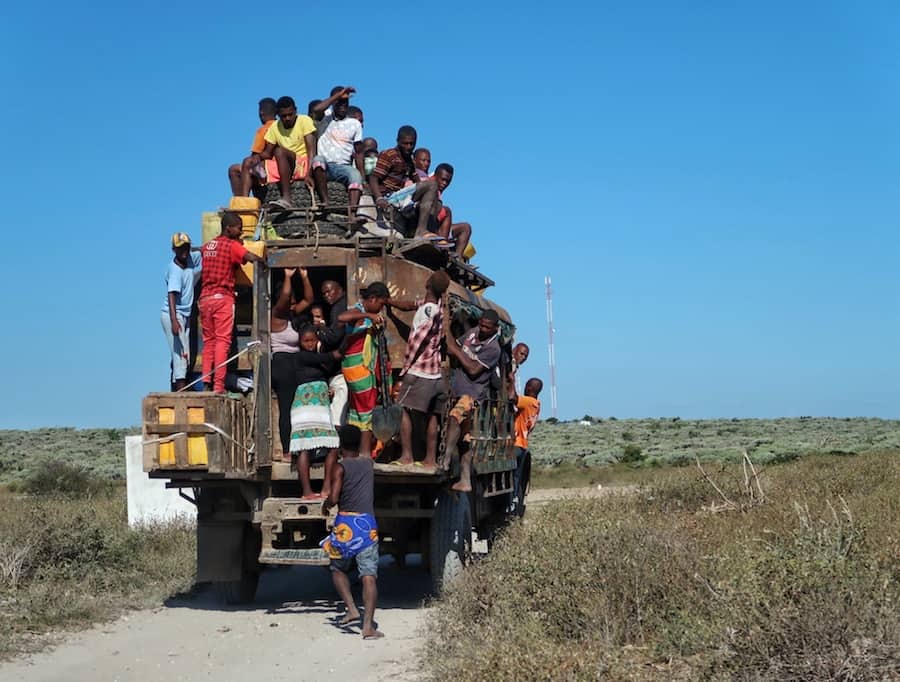
Time and patience are the keys to a great trip in Mada. My patience was certainly pushed to the limit when a battery fault meant that a 4-minute ferry crossing was delayed by OVER THREE HOURS.
Did I lose my cool? Sure – we arrived at our next destination at night with no time to enjoy the sites! These things happen when you travel and happen a lot in Madagascar. Drivers can be late due to misinformation and we can’t even count how many vehicles we saw broken down on the road!
Despite this, we had an absolutely amazing, mostly trouble-free, time in Madagascar. We especially loved experiencing nature and wildlife in the country.
Madagascar was definitely an adventure we’ll never forget! So to answer the question ‘is Madagascar worth visiting‘ I’d have to say it’s definitely a yes from us!


